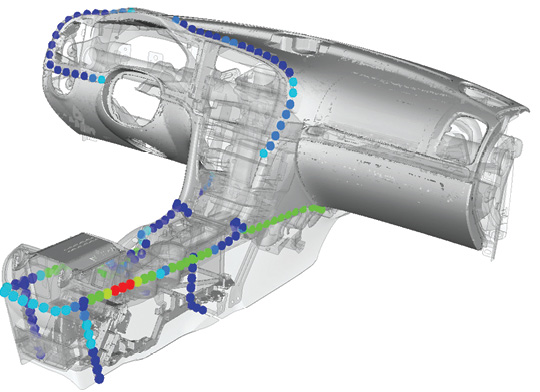
National Electric Vehicle Sweden uses Altair’s Squeak and Rattle Director to identify and solve root causes of sounds in automotive assemblies. Image courtesy of Altair.
Latest News
October 1, 2017
NVH—the study of noise, vibration, and harshness—is supported by software and simulation tools. As the automotive industry transitions from combustion engines to electric and hybrid cars, NVH tools also evolve to address new issues.
National Electric Vehicle Sweden, the new owner of what used to be Saab Automobile AB, is currently using Altair’s Squeak and Rattle Director, described as a software set a set of software automations that “rapidly identify and analyze design alternatives to eliminate the root causes of squeak and rattle in assemblies.” DE spoke to NVH experts from Altair for more info.
 National Electric Vehicle Sweden uses Altair’s Squeak and Rattle Director to identify and solve root causes of sounds in automotive assemblies. Image courtesy of Altair.
National Electric Vehicle Sweden uses Altair’s Squeak and Rattle Director to identify and solve root causes of sounds in automotive assemblies. Image courtesy of Altair.DE: What are the pros and cons of losing the combustion engine?
Jianmin Guan, director, Vibration and Acoustic Solutions: In a traditional car, the combustion engine—to use industry vernacular—“masks” a lot of the NVH problems, like extraneous noises from accessories and components. In a fully electric vehicle, the engine is no longer there, so these issues become much more prominent to the driver and the passengers. For example, wind and road noises become more prominent.
And all cars have cooling systems, which use pumps. Their sound is not very loud, but can be fairly disturbing if the engine noise is no longer masking it. And even though you no longer have the engine, you still have the gear, so the gear noise becomes more prominent. Usually, engineers have to solve these problems by adding dampening, stiffing or absorption materials.
Unlike a combustion-engine car, the electric vehicle produces very little external noise, so the pedestrians might not easily recognize its approach. So, by requirement, electric vehicles must make some noise to alert the pedestrians.
DE: How is simulation integrated with human perception?
Jianmin Guan: People generally perceive a car that vibrates too much as a low-quality product. Without the engine, the car has lost one source of vibration. At the same time, without the engine’s vibration, road-induced vibration becomes more prominent. So it can accentuate the perception of low quality.
Andrew Burke, product design team manager: With NVH, the driver or the customer is the sensor, if you’d like. The driver is the one making the assessment and measurement, whether consciously or subconsciously. So we have to take into account the human perception. With our tools, you can link the simulated noises to a [physical vehicle] simulator, so you can “experience” what it sounds like to be the driver. In some companies, using AR-VR (augmented reality and virtual reality) hardware to experience the simulation is now standard procedure.
Based on research data, you could understand how a human would perceive noise or vibration by looking at a plot [in simulation]. But there are also subjective reactions you won’t get by just looking at a plot. So, now that we have the technology, it’s really important to feed these simulated data into a simulator so you can experience it. That helps you make better design changes.
DE: What about full-system NVH simulations?
Jianmin Guan: When you do a full-vehicle NVH simulation, you’re looking at how all the individual components are coming together and matching one another. So compatibility of components is one issue to look at. If you turn on the engine and you feel the steering column shaking too much, you’d consider that car not too refined. The problem might even contribute to breakage and failure. But that shake is not the result of a single component, but the design issue of the entire structure. It has to do with how the steering column is fastened to the body. To solve such a problem, you need to look at the full vehicle. DE
Kenneth Wong is DE’s resident blogger and senior editor. Email him at [email protected] or share your thoughts on this article at digitaleng.news/facebook.
More Info
Subscribe to our FREE magazine, FREE email newsletters or both!
Latest News
About the Author
Kenneth Wong is Digital Engineering’s resident blogger and senior editor. Email him at [email protected] or share your thoughts on this article at digitaleng.news/facebook.
Follow DE





